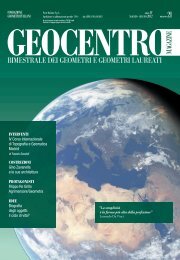Geocentro Magazine - numero 6 - novembre/dicembre 2009
Geocentro Magazine - numero 6 - novembre/dicembre 2009
Geocentro Magazine - numero 6 - novembre/dicembre 2009
Create successful ePaper yourself
Turn your PDF publications into a flip-book with our unique Google optimized e-Paper software.
). Il passaggio dal rilievo alla carta avviene poi attraverso una<br />
sintesi individuale di elementi percettivi, metrici ed ordinali,<br />
che propongono sempre una visione diagrammatica dello<br />
spazio, percepito e delineato nella sua unitarietà.<br />
Il suo più alto contributo alla rappresentazione del territorio<br />
riguarda specialmente la componente verticale dei monti e<br />
dei laghi. Il metodo che Leonardo impiega nella restituzione<br />
grafica delle masse orografiche si basa sul tentativo di<br />
delineazione delle forme di monti e colline nel rispetto dei<br />
loro mutui rapporti di proporzionalità e nell’introduzione<br />
della sua teoria delle ombre, che conferisce alle carte una<br />
forza comunicativa senza precedenti e conferma l’importanza<br />
cartographical science.<br />
Talking about the representation, during the Renaissance<br />
new surveyors, painters and miniaturists went further into<br />
the creation of maps with greater power of description and<br />
expression.<br />
After more or less fi fty years since the publishing of Alberti’s<br />
essays, another genius in both Art and Science, Leonardo da<br />
Vinci (1452-1519), gave a unique, original contribution<br />
to this discipline, thanks to the methods proposed by Leon<br />
Battista Alberti and to the Ptolemaic Geographia, both in<br />
the drawing techniques from the reality (through perspective<br />
instruments such as the “Velo”, conceived by Alberti in order<br />
to establish a geometrical correspondence with a perspective<br />
view) and in the methods of surveying and sketching maps.<br />
Leonardo’s maps stand out a mile from the naïve and childish<br />
sketches realised by the surveyors and the experts of the time,<br />
even if his interest for the cartographical representation doesn’t<br />
have a professional purpose.<br />
Leonardo isn’t a cartographer, but he deals with this science<br />
for scientifi c and analytic purposes: landscape planning and<br />
war strategies.<br />
In order to understand his cartographical work, we need to<br />
take a step behind, shifting our focus from the maps to the<br />
representations more in general; that’s to say to the language of<br />
the drawings and of the paintings. For Leonardo, this latter<br />
wasn’t a mere visual repetition of what was already known;<br />
instead, it was “the key to open the world of phenomena” (as<br />
Giulio Carlo Argan said).<br />
Th e innovative basis of his cartographical production, therefore,<br />
can be found in the rules enunciated in the Libro di pittura.<br />
Th e way Leonardo chooses to survey and graphically represent<br />
a piece of land is summarised in the rule given in his own note<br />
in the Manuscript L, France Institute (f. 21 r): “On the top<br />
of the hills and on theirs sides, look at the shapes of the land<br />
portions, at their division, and at all the things in front of<br />
you, and draw them in their own shape”. Th e transformation<br />
from the sketch to the map is done through a personal synthesis<br />
of perceptive elements, metric and ordinal, always giving a<br />
diagrammatical view of the land (conceived and represented<br />
as a whole).<br />
Leonardo’s contribution to an accurate landscape representation<br />
is particularly relevant for what concerns the vertical component<br />
of mountains and hydrography. In the graphical reproduction<br />
of mountainous blocks, he tries to sketch the shapes of every<br />
massif and hill following their mutual proportions. Moreover,<br />
his “theory of the shadows” gives to the maps a communicative<br />
power never achieved before, a proof of the importance of a<br />
careful study on them. “… shades in painting need much more<br />
investigation and speculation than their outline; and evidence<br />
of this precept is that the outline can be made to shine using<br />
veils transparency, or fl at glass placed between the eye and the<br />
thing to be drawn; but this rule does not apply to shades, due<br />
to the lack of sensitivity of their shape, for, more often than<br />
69






